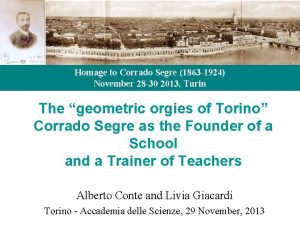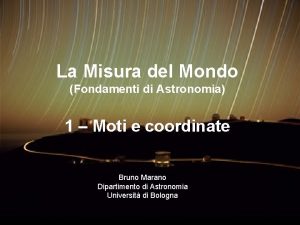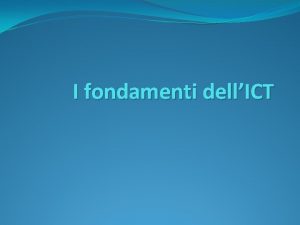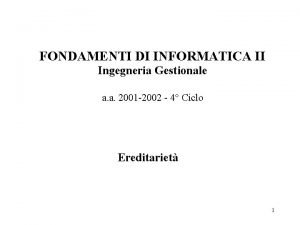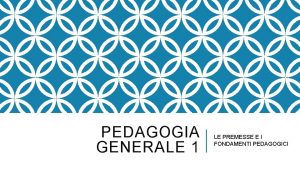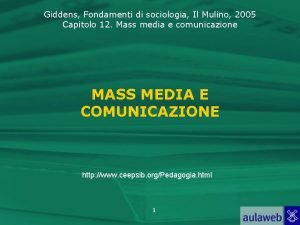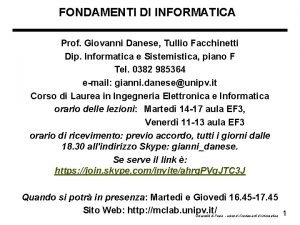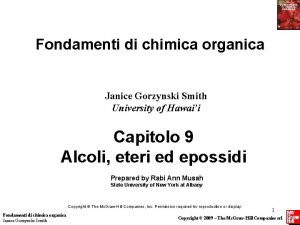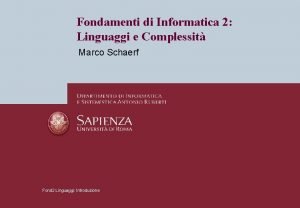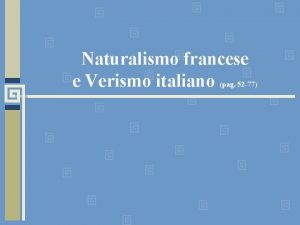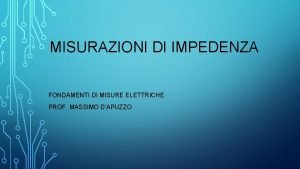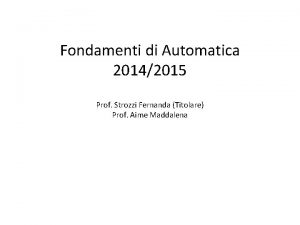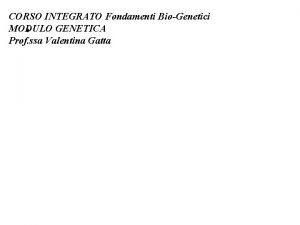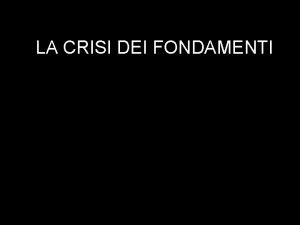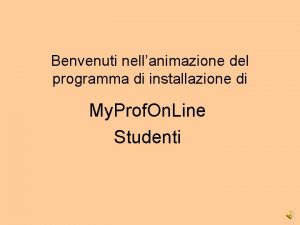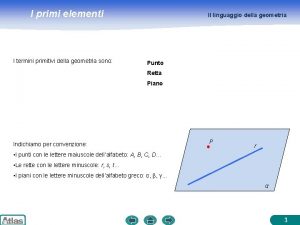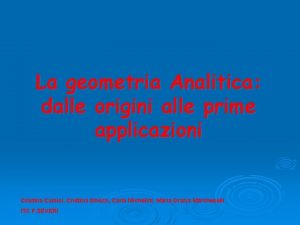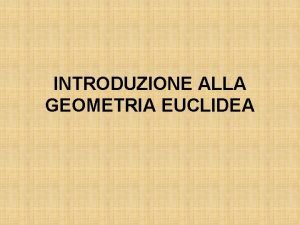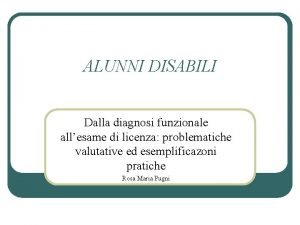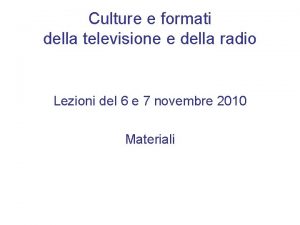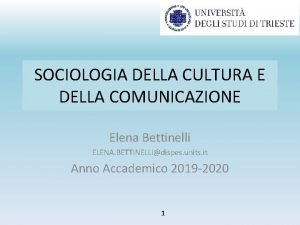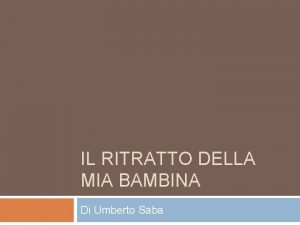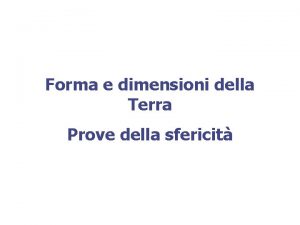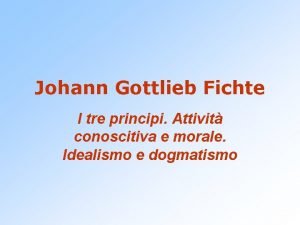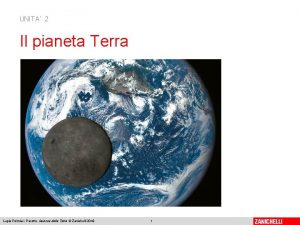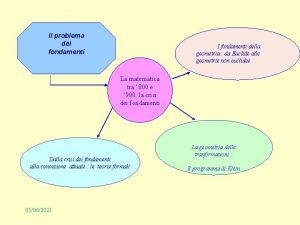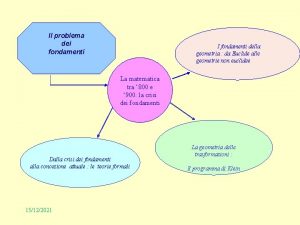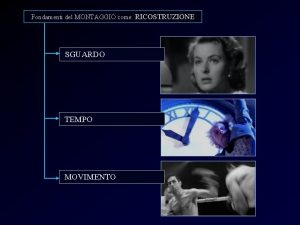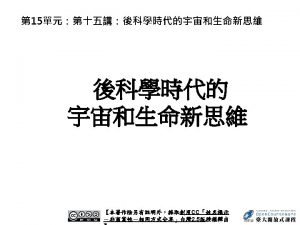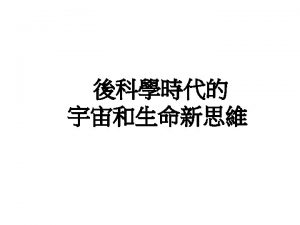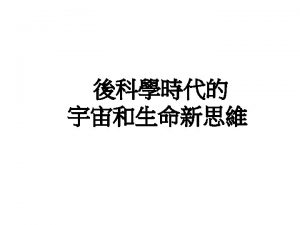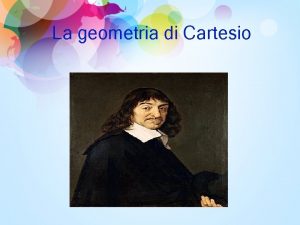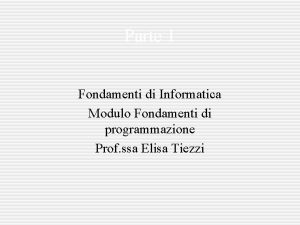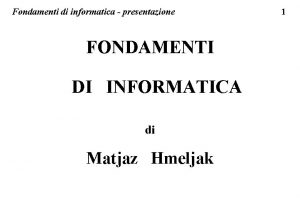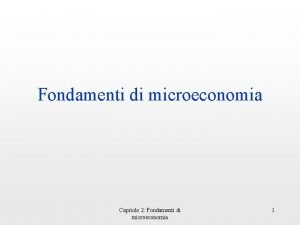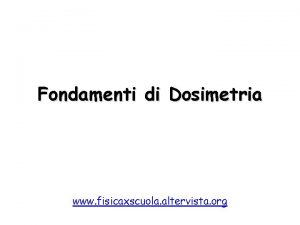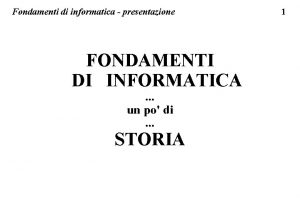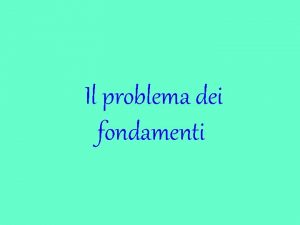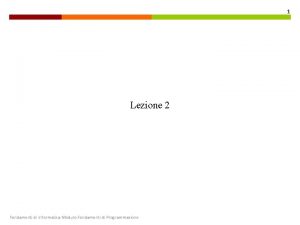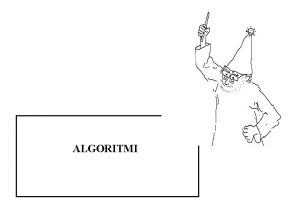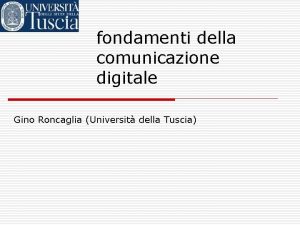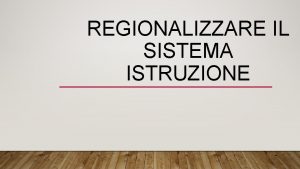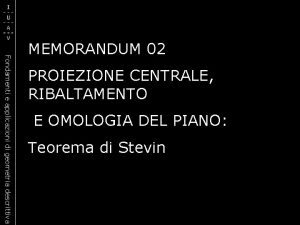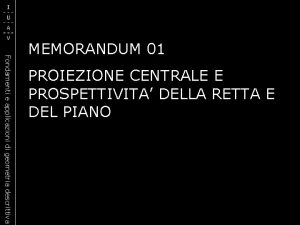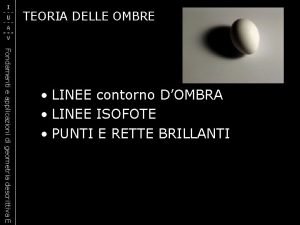Segre e i fondamenti della geometria dalla geometria






![Segre’s first interests towards foundational problems • Egli [Reye] definisce gli elementi imaginari appunto Segre’s first interests towards foundational problems • Egli [Reye] definisce gli elementi imaginari appunto](https://slidetodoc.com/presentation_image/cd2771057ce911f2d3e773769ad2e15d/image-7.jpg)




























- Slides: 35

Segre e i fondamenti della geometria: dalla geometria proiettiva complessa ai numeri duali Aldo Brigaglia Università di Palermo

Bibliography • C. Zappulla, Doctoral Thesis, University of Palermo • T. Hawkins, The emergnce of Lie Groups • L. Giacardi, (editor), I quaderni di Segre, CD • E. Luciano, C. S. Roero, From Turin to Goettingen • C. Cerroni, C. Zappulla, The history of the algebra of bicomplexes, work in progress

Segre to Klein, February, 25, 1886 • Je suis en train d’écrire un travail en italien de géométrie projective pure sur la théorie de couples d’éléments imaginaires. La théorie que Staudt a donné dans ses Beiträge est compliquée par la séparation qu’il a faite des éléments imaginaires conjugués

Segre to Klein, October 14, 1887 • C. Segre, Le coppie di elementi imaginari nella geometria proiettiva sintetica, Memorie della Reale Accademia delle Scienze di Torino, (2), 38, 1886, pp. 3 – 24. • Mon admiration pour la Geom. d. Lage (et Beiträge) de Staudt va avoir la satisfaction d’en voir paraître une version italienne (pour à – présent, seulement de la G. d. L. ) : ce que ma maladie aux yeux ne me permettait pas de faire, un jeune géomètre qui est ici, M. Mario Pieri, le fera

Castelnuovo on Segre’s main research interests • Projective hyperspacial algebraic geometry (since his thesis, 1883) • Birational algebraic geometry (since 1886) • Nel fare, son già vari anni, delle ricerche sulle ricerche algebriche. . . avendo io avuto bisogno di valermi delle proprietà delle serie lineari studiate nella memoria di Brill – Nöther mi accorsi come. . . rappresentando quelle serie lineari mediante curve iperspaziali. . . si potessero ritrovare (almeno in parte) quelle proprietà mediante semplici ragionamenti geometrici, evitando i calcoli algebrici o le considerazioni funzionali.

• Projective Geometry on an Algebra (complex or hypercomplex) • Projective differential Geometry (since 891) • Continuo a divertirmi con la geom. Delle superficie. E’ proprio un errore di dedicare quasi tutti i corsi di geom super agli enti algebrici. Gli enti generali sono pure interessantissimi In my talk I will speak about the third issue, perhaps the less known
![Segres first interests towards foundational problems Egli Reye definisce gli elementi imaginari appunto Segre’s first interests towards foundational problems • Egli [Reye] definisce gli elementi imaginari appunto](https://slidetodoc.com/presentation_image/cd2771057ce911f2d3e773769ad2e15d/image-7.jpg)
Segre’s first interests towards foundational problems • Egli [Reye] definisce gli elementi imaginari appunto come i due elementi uniti di una proiettività di forme di 1 a specie sovrapposte, le quali non abbiano punti uniti (reali). Tale definizione, che anche altri autori usano, mi pare assolutamente da rigettare, perché contiene evidentemente in sé qualche cosa di assurdo, e nello stesso tempo introduce gli elementi imaginari con una locuzione che non sta per significare alcun ente geometrico. Essa rassomiglia alla definizione che alcuni danno di una coppia di punti imaginari coniugati di una retta: la coppia dei punti d’intersezione di questa con un circolo che non la incontri.

• Osservazioni analoghe a quelle che ho fatto riguardo ai modi con cui ordinariamente si introducono gli elementi imaginari valgono per gli elementi all’infinito (punti, rette e piano). Il solo modo rigoroso d’introdurre ad esempio i punti all’infinito come enti geometrici, sì da poterne far uso nei ragionamenti, è di definirli non già come punti d’intersezione (come fanno in sostanza quasi tutti gli autori), ma bensì come sinonimo di direzioni, oppure, se si vuole, di stella di rette parallele. La considerazione che si suol usare del fatto che quando due rette del piano tendono a diventar parallele il loro punto d’intersezione s’allontana indefinitamente non può servire che per giustificare la scelta della locuzione punto all’infinito, ma non per definirla, se si vuole, come si deve volere (lo ripeterò ancora), che essa significhi un ente geometrico.

Didactical vs. Scientific Problems • fu appunto pel corso di geometria proiettiva che ero incaricato di fare quest’anno nell’università di Torino che imaginai questo metodo • M. Pasch, Vorlesungen über neuere Geometrie, 1882: the point of depart of both Segre and Peano

1889 – 1890 • C. Segre, Un nuovo campo di ricerche geometriche, Atti della Reale Accademia delle Scienze di Torino, 25, 1889 -90, pp. 180 – 205; 290 – 317; 376 – 396 e 26, 1890 – 91, pp. 35 – 71. • A new discipline: complex projective geometry

New geometrical objects • Antiprojectivities given by antilinear transformations • Chains (kette in Staudt’s work, but here they are introduced only for the complex line) • Hyperalgebraic varieties, defined through algebraic functions of complex variables and their complex conjugate. • Chains are fixed points of antiprojectivities, so for the Riemann sphere they are simply circles (or straight lines) • The most important hyperalgebraic varieties are determined through hermitian forms (hyperconics and hyperquadrics).

A geometrical interpretation of many analitical results in the study of complex variables functions • Già in certe ricerche analitiche recenti si [ha] un esempio particolare di cose che qui si tratteranno geometricamente. Negli studi. . . sulle funzioni di una variabile complessa le catene semplici descritte da questa, cioè i circoli che le rappresentano nel piano o nella sfera su cui la variabile vien distesa sono usati frequentemente: in particolare essi furono adoperati nelle ricerche delle funzioni che non mutano per un gruppo di trasformazioni lineari della variabile, e in particolare in quelle generali e profonde del sig. Poincaré sulle funzioni fuchsiane e kleiniane. . .

• Ed effettivamente nelle ricerche sulle funzioni di due variabili complesse fatte in questi ultimi anni dai sig. i Picard e Poincaré e specialmente in quelle del primo sulle funzioni che egli chiamò iperfuchsiane, si trovano usate le iperconiche, definite in modo diverso dal nostro. . . Il sig. Picard si trova così condotto necessariamente a qualche ricerca sulla riduzione della (3) [cioè delle forme hermitiane] a forma canonica i cui risultati nella trattazione geometrica appariranno evidenti. E prosegue in nota: Aggiungerò che le forme del tipo (3) [hermitiane]. . . a coefficienti complessi interi si sono pure già introdotti nella teoria dei numeri grazie ai sig. i Hermite, Picard ed altri.

To translate from analysys and algebra into geometry and viceversa • Le rappresentazioni reali delle forme complesse e gli enti iperalgebrici, Mathematische Annalen, 40, 1891, pp. 413 – 467.

The Algebra of Bicomplex Numbers They are obviously isomorphic commutative algebras with zero divisors. Biquaternions were defined by Hamilton in 1853. They are also used by Lipschitz in 1884

Segre clear insight • Segre correctly puts his bicomplexes in the general setting of the newborn theory of linear algebras (hypercomplex numbers) • Tali corpi furono studiati in generale dal sig. Weierstrass, i cui risultati vennero pubblicati … solo recentemente [1884] … Questa pubblicazione fu tosto seguita … da altre … dei sig. Schwartz (1884), Dedekind (1885), Holder (1886) • Something missing: above all Frobenius (but Segre knows his works)

Zero divisors • Il punto fondamentale in cui i numeri complessi generali a più unità … si staccano dagli ordinari numeri complessi ad una sola unità imaginaria è quello che … , mentre pei numeri complessi ordinari un prodotto s’annulla solo quando s’annulla uno dei suoi fattori, nei campi più generali esistono dei numeri particolari non nulli, i quali moltiplicati per convenienti numeri parimenti non nulli danno zero.

A deep insight • Only one example of attention to structural properties: • Every bicomplex number may be decomposed in the sum of two zero divisors

Delusion: a letter to Hurwitz, Juin 29 1894 • Colgo quest’occasione per richiamare la Sua attenzione anche sulle mie Note (che Ella ha) intitolate “Un nuovo campo di ricerche geom. ” e “Le rappresentaz. i reali delle forme complesse …” perché se Ella, proseguendo le sue ricerche aritmetiche passerà alle forme di Hermite, troverà forse qualche punto di contatto con quei miei lavori. Infatti io studio ivi, fra gli altri enti iperalgebrici, quelli che chiamo iperconiche, ecc. che sono rappresentati analiticamente da equazioni di Hermite; e che così danno l’equivalente geometrico delle forme di Hermite: come le coniche, ecc. danno l’immagine geometrica delle forme di Dirichlet (ternarie, ecc. ). Né il Fricke né il Bianchi non hanno ancora approfittato di questi miei lavori, ma io dono persuaso che un profitto se ne possa trarre studiando le questioni aritmetiche con sussidi geometrici.

Delusion: Segre and Castelnuovo, 1889 and 1924 • Ora da qualche settimana ho ripreso antiche questioni sugli enti imaginari nelle forme di 1 a, di 2 a, … specie, sulla loro rappresentaz. e in forme reali, (i p. i del piano nei p. i reali di S 4, ecc. ) e ho trovato e trovo dei risultati che spero ti interesseranno. In certi punti si può dire che continuo i Beiträge di Staudt (scrivimi che impressione ricevi da questi) • hanno avuto in modo diretto od indiretto importanti riflessi, dapprima forse però d'entità inferiore a quanto l'A. non ne aspettasse. (B. Segre) • Queste ricerche. . . non hanno trovato sinora il largo appoggio sul quale egli forse faceva assegnamento. Le innovazioni o generalizzazioni penetrano lentamente nella scienza, a meno che esse non portino una economia di pensiero nello studio di quei problemi che, in un determinato periodo, attirano l’attenzione dei ricercatori

Castelnuovo • Va pure osservato che, mentre egli aspira ad aprire nuove vie alla indagine geometrica, non si sforza poi di percorrere queste vie fin dove appaiono feconde … Questa tendenza … ha immensamente favorito l’attività della scuola che da lui prende il nome. Infatti i discepoli, da lui spinti nelle direzioni che egli aveva segnato e coi metodi di cui si era valso, hanno potuto affrontare e risolvere ardue questioni mettendo così in rilievo la fecondità di quegli indirizzi e quei metodi. • In our case, no mathematical school in Italy • A new field of geometrical research, but, from the point of view of Italian algebraic geometry, poor of results

A first student (not Italian): Coolidge • In the academic year 1903 – 1904, Coolidge attended to the lessons of Higher Geometry held in Turin University by Corrado Segre on Applicazioni degli integrali abeliani alla geometria.

A bridge between Segre and Study • After his studies in Turin he went in Germany to study with Study. To the links with both Segre and Study, Coolidge owed his deep interests in the geometrical interpretation of complex numbers and their functions, a subject wich always fascinated him.

Papers of Coolidge influenced by Segre • Some of the principal papers written by Coolidge under the influence of Segre and Study: • Die dual – projektive Geometrie im elliptischen und spharischen Raume. Dissertation, 1904. • Les congruences isotropes qui servent à representer les fonctions d’une variable complexe, Atti Acc. Torino, 1904. • The elements of non euclidean geometry, Clarendon, 1908. • A study of the circle cross, Trans. Of the AMS, 1913. • A treatise on the circle and sphere, Clarendon, 1916. • The characteristic numbers of a real algebraic plane curve, Rend. Palermo, 1917 • The geometry of the complex domain, Oxford University Perss, 1924 • Questioni di geometria nel campo complesso, Rend Roma, 1928. • A Treatise on algebraic plane curves, Clarendon, 1931

Homage to Segre 1, Coolidge • Every student in complex domain will find that he is forced to refer continually to the work of two admirable contemporary geometers, Professor Corrado Segre of Turin, and Professor Eduard Study of Bonn. The names of both appear throughout this book; the author had the rare privilege to be the pupil of each of these masters. Geographical separation has cut him off from the one, the inexorable logic of history has impeded his communion with the other. But his sense of obligation has never wavered, and he begs to offer the present work as a small token of admiration and esteem

Segre / Study • Few geometers set a higher value on Segre’s work than Study did (Coolidge) • The same conceptual schema, but very different uses. Segre algebraic geometry, Study Lie groups

Pieri, an axiomatic approach • Nuovi Principi di Geometria Projettiva Complessa, Mem. d. Regia Acc. d. Scienze di Torino, 2, 55, 1904 -05, pp. 189 -235 • Segre’s results reorganized from an axiomatic point of view

1890 / 91 • A new and very different project. • A course on higher geometry: Introduzione alla Geometria sugli enti algebrici semplicemente infiniti Students: Gino Fano, Federico Amodeo • Definire lo spazio Sr non già mediante coordinate, ma con una serie di proprietà dalle quali la rappresentazione con coordinate si possa dedurre come conseguenza • Very important consequences the papers by Fano and Enriques on Foundations of ndimensional projective geometry

1907: Fano and Lie Groups • Kontinuierliche geometrische Gruppen. Die Gruppentheorie als geometrisches Einteilungsprinzip, Enzyklopädie der mathematischen Wissenschaften, III, 4 a, 1907, pp. 221 – 288. • 1912 / 14: Elie Cartan studies this paper and he will translate it into French (not published owing to the war, and published only in his Oeuvres)

1907: Fano and Lie Groups Kontinuierliche geometrische Gruppen. Die Gruppentheorie als geometrisches Einteilungsprinzip, Enzyklopädie der mathematischen Wissenschaften, III, 4 a, 1907, pp. 221 – 288. 1912 / 14: Elie Cartan studies this paper and he will translate it into French (not published owing to the war, and published only in his Oeuvres)

1913 - 14: Elie Cartan • Cartan’s trilogy (T. Hawkins) • Les groupes projectifs qui ne laissent invariante aucune multiplicité plane, Bulletin des Sciences mathématiques, 4 1, 1913, pp. 53 – 96; • Les groupes projectifs continue réels qui ne laissent invariante aucune multiplicité plane, Journal des mathématiques pures et appliquées, 10, 1914, pp. 149 – 186; • Les groupes réels simples finis et continus, Annales scientifiques de l’École Normale Supérieur de Paris, (3), 31, 1914, pp. 263 – 355. • Large use of Segre’s results.

1915: Cartan and Fano • La théorie des groupes finis et continus et la géométrie. Exposé d’après l’article allemand de G. Fano, Encyclopédie des sciences mathématiques, III, 1, 1915. • 1927 B. Segre studies with Cartan

1929 - 30: Cartan Lessons at the Sorbonne, winter 1929 – 30 • Leçons sur la Géométrie projective complexe, Gauthier Villars, 1931

Homage to Segre 2, Cartan • La géométrie projective complexe, considéré comme discipline autonome, . . . , c’est principalement développée à la suite des travaux de Juel et surtout de C. Segre. Ce dernier géomètre a montré l’importance des transformations antiprojectives. . . à coté des transformations projectives, qu’on avait seules considérées auparavant. Parmi les antiprojectivités, les antiinvolutions et les antipolarités font intervenir des êtres géométriques dont le rôle ne le cède en rien à celui joué par les quadriques et les complexes linéaires, envisagés comme éléments de base des polarités proprement dites • A tool for the study of Lie Groups

Dual Numbers • 1911: Le geometrie proiettive nel campo dei numeri duali, Atti della Real Accademia delle scienze di Torino, 47, 1911 – 12, pp. 114 – 133 and 164 – 185
 German segre
German segre Corrado segre
Corrado segre Fondamenti di astronomia
Fondamenti di astronomia I fondamenti dell'ict
I fondamenti dell'ict Fondamenti di informatica 2
Fondamenti di informatica 2 Pedagogia generale slide
Pedagogia generale slide Giddens fondamenti di sociologia
Giddens fondamenti di sociologia Giovanni danese
Giovanni danese Chimica organica
Chimica organica Fondamenti di informatica 2
Fondamenti di informatica 2 Naturalismo francese e verismo italiano
Naturalismo francese e verismo italiano Fondamenti di misure
Fondamenti di misure Controllo ad anello aperto
Controllo ad anello aperto Fondamenti biogenetici
Fondamenti biogenetici Crisi dei fondamenti
Crisi dei fondamenti Fondamenti di automatica benvenuti
Fondamenti di automatica benvenuti Tre enti fondamentali della geometria
Tre enti fondamentali della geometria Assioma di partizione del piano
Assioma di partizione del piano Rene descartes geometria analitica
Rene descartes geometria analitica Geometria euclidea significato
Geometria euclidea significato Attestato di credito formativo compilato
Attestato di credito formativo compilato Culture e formati della televisione e della radio
Culture e formati della televisione e della radio Soluzioni il racconto della chimica
Soluzioni il racconto della chimica Serie di bowen
Serie di bowen La coccinella in cerca della felicità
La coccinella in cerca della felicità Lavorazione della seta fasi
Lavorazione della seta fasi Elena bettinelli
Elena bettinelli Soluzioni il racconto delle scienze naturali
Soluzioni il racconto delle scienze naturali Parafrasi ed amai nuovamente
Parafrasi ed amai nuovamente Prove della sfericità della terra
Prove della sfericità della terra Simonetta klein il racconto della chimica
Simonetta klein il racconto della chimica Il racconto della chimica e della terra 2 esercizi svolti
Il racconto della chimica e della terra 2 esercizi svolti Soluzioni il racconto della chimica e della terra
Soluzioni il racconto della chimica e della terra Fichte 3 principi
Fichte 3 principi Prove sulla sfericità della terra
Prove sulla sfericità della terra Moti millenari della terra zanichelli
Moti millenari della terra zanichelli

